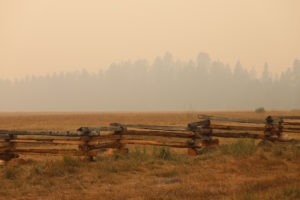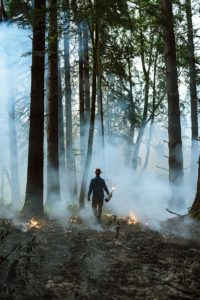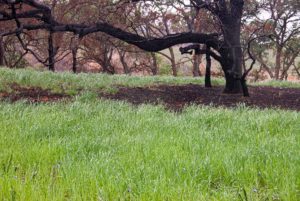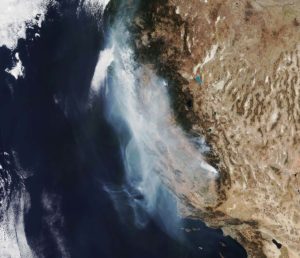Lying on a rock to the side of the Las Trampas Ridge Trail, I watch a red-tail surfing the thermals. It is eyeing the dense chaparral habitat that covers these slopes in patches like thick wool on a sloppily shorn sheep. I suppose it is searching the edges of the almost impenetrable vegetation that surrounds me for emerging prey. I envy the arching ride and the perspective its altitude grants. Yet that vision-dominated hawk is missing much: the crazy buzzing of a thousand bees come to drink nectar from the urn-like manzanita blossoms on this late January day; the steam rising off the duff collected under the shrub, drenched by yesterday’s rains and heated by today’s first rays of sun; and those intoxicating chaparral smells, at once pungent and mentholated, funky and fresh.
From the hawk’s vantage, the chaparral must appear monolithic. And on the surface, it is. It is often composed of only a few types of plants. Sometimes stands are more than 95 percent chamise (often called greasewood), a rugged, super-flammable shrub with small, thick leaves and blossoms that resemble tiny wild roses. Sometimes ceanothus dominates. Or scrub oak. Or the beautiful manzanita, with its chestnut-like wood and small red berries, the “little apples” from which its name derives. Sometimes all of these species commingle with toyon or mountain mahogany, or dominance shifts gradually from one species to the next depending on the slope, soil conditions, water sources, and exposure. But all of these plants have a few things in common that allow them to thrive where summers are dry and hot, and where winters are short and wet. All are evergreen; all have thick, small, waxy leaves that help them conserve water. All are short, never growing more than 15 feet tall and only rarely growing over 6, and all have some strategy or other to survive fire.
- The endangered Alameda whipsnake, like this one in Garin Regional Park,hunts mostly under the protective branches of chaparral vegetation.Photo by Joe DiDonato.
In California, and in the four other Mediterranean climatic zones around the world, chaparral grows where little else can, in rocky soils poor in nutrients, including sandstone, granite, siliceous shales, and serpentine. Throughout the Bay Area, chaparral is often found on the dry, hot, south-facing slopes of hills, while on the wetter, gentler, north-facing slopes grow the deciduous shrubs and trees that can make a better living there.
Although chaparral is the most extensive vegetation type in California, covering about one-twentieth of the state’s landscape and one-twelfth of the Bay Area’s, it is probably the least well studied of the state’s major terrestrial vegetation types. Even though it is easy to get near to, like the deep sea it is quite hard to get into. (The word chaparral, derived from the Spanish for “the place of the chaparro or scrub oak,” also explains the word chap, from the Spanish term for the heavy leather leggings invented to protect horseback riders moving through the dense, low, tangled shrubs.) Not all researchers have the fortitude of Irene Brown, a biologist who studies checkerspot butterflies at Jasper Ridge Biological Preserve near Stanford, where they feed on sticky monkeyflower, a plant associated with chaparral. Aside from her butterfly research, Brown is known for her technique of swimming through the shrubs to do it. A few other hardy researchers will crawl through its understory on hands and knees, or slither on their bellies, but most choose to study something else instead.
Unless a trail is cut through dense chaparral, most people won’t even try to enter it. Nor probably should they. Once it’s burned, however, access is easy. And rewarding. More than 50 years ago, the late California Academy of Sciences botanist John Thomas Howell came upon wildflowers blooming in the charred “remains” of a chaparral wildfire on the side of Mount Tamalpais. He had never seen a display to match it. “It’s a wonder,” he wrote, “that ecologists don’t become arsonists in order to behold the beauty after burns.”

-
An aerial view of a ridge at Las Trampas Regional Wilderness shows aclear delineation between open grassland (on the left) and the densecloak of chaparral (on the right). Photo by Saul Chaikin.
Difficult access for humans is a boon for the many animals that rely on chaparral as part of the larger mosaic of Mediterranean habitat types, which generally also include woodland, grassland, and streamside, or riparian, zones. Mountain lions will sleep within chaparral’s protective cover, retreating there to consume prey caught outside, and sometimes even making their dens within. Wood rats and other rodents occupy Bay Area chaparral and many bird species such as California quail and wrentits take shelter and nest in its branches. Foxes eat manzanita berries and also, along with coyotes, sometimes nest inside the chaparral, where they undoubtedly prey on brush rabbits, which often ply the edges to eat grasses and forbs. Rattlesnakes, whiptail lizards, and, in the East Bay hills, endangered Alameda whipsnakes all occupy chaparral.
“The whipsnake requires a mosaic of grassland, chaparral, and scrub to support a population,” says herpetologist and biological consultant Karen Swaim. The “whip” in whipsnake refers to the speed and agility the animal employs in catching fence lizards, its primary prey. That speed is fueled by a high mean active body temperature, the highest, in fact, of any snake whose mean active body temperature has been measured. To generate the heat, whipsnakes spend a lot of time lying in the sun, and they can sometimes be found warming themselves on rocky chaparral- and grassland-surrounded outcroppings such as those in Tilden and Black Diamond Mine Regional Parks.
But remember the hawk cruising overhead in Las Trampas? It would happily trade its good view for a meal, and the whipsnake knows it. So the reptile spends as little time as possible in the open, and hunts mostly under the protective branches of chaparral vegetation. Raptors will sometimes go a short way into chaparral, according to EBRPD biologist Steven Bobzien, who has seen Cooper’s hawks and sharp-shinned hawks run into the thick brush after birds or rabbits. But they can’t travel very far or very fast in there, and they much prefer to take their prey from adjoining grassland. So the key to the whipsnake’s success is access to shrubbery that is dense enough to provide protection, yet open enough for the sun to penetrate and provide warmth and energy.
Another denizen of Bay Area chaparral is the California thrasher, a good-sized, drab-colored bird that sings like a mockingbird almost year-round. But unlike its extroverted sing-alike, the thrasher is rarely seen. “It’s always there, tempting you with its colorful song,” says ornithologist Doug Bell, a biology professor at California State University in Sacramento, “but you can hardly ever see it through the thick brush.”
The thrasher mostly eats insects, which it uncovers by vigorously raking the leaf litter back and forth with its long, decurved beak. After stirring up the duff, it stares into the mess it has made and pecks out the edible bits. Pairs of California thrashers form long-term relationships and are often seen singing and foraging together. Young thrashers leave the nest before they can fly very well and are therefore, like California quail, easy targets for the growing numbers of feral cats so common on urban and suburban boundaries. Like so much of the ecology of chaparral fauna, the California thrasher is largely a mystery. “The damn thing is a phantom in the brush, so common in many places, living next to millions of people, yet so little known,” says Bell.
As I walk up the slopes of the Hidden Valley Wilderness Trail in Mission Peak Regional Preserve, I remind myself that while it may appear monotonous, in reality chaparral is both ecologically complex and biologically diverse. It is a latent regal, hiding gems and silks within its rough brown-green coat of tangled branches. Only fire brings forth its true colors, says paleobotanist Steve Edwards, director of the Regional Parks Botanic Garden in Berkeley’s Tilden Park. “Most chaparral in California is just chamise with a few toyon and a few woody plants,” he says. “But when it burns 30 species may come up! You’ve got to remember, those are part of the chaparral community, too, even if you only see them once every 50 years.”
In 1944, Mary Bowerman published the first edition of her remarkable book Flowering Plants and Ferns of Mount Diablo. She believed her work was more or less complete until 33 years later, when a fire spread through the chaparral in Diablo’s Donner Canyon. The next spring the hills of the canyon were dense with the bright orange fire poppy, a plant not previously recorded there. Who knows how long the seeds had been waiting for their moment in the sun? Only a few poppies returned the following year as woody chaparral species reoccupied the fire zone. The flower has since disappeared. But its seeds remain, impervious to water and the passing decades, waiting for another chance to erupt.
No plant could survive in chaparral without some way of coping with fire. Some, like oaks and toyon, are sprouters, which means they quickly resprout from their charred bases, or burls, after a fire burns off their tops. These plants typically have vulnerable seeds that remain viable for only one year but are well suited to sprouting and taking root in the duff and shelter of mature chaparral. They typically grow roots that tap deep water sources, a strategy that allows them to survive the normal dry conditions.
If the obligate sprouters invest in staying alive through fires, the obligate seeders, such as manzanita and ceanothus, generally die and burn up in fires, but invest in the next life by making seeds that may last a century in the seed bank and are physiologically suited to grow fast after a fire. These seeds are waterproof and may require the shock of intense heat, cracking the hard seed coat, to germinate.
Research by Stanford botanist David Ackerly and his students is revealing that some chaparral plants have taken fire tolerance one step further. Chamise and some ceanothus hold on to their dead branches, building kindling-like piles of brush in their understory. “If you’ve ever built a fire you know what I’m talking about,” says Ackerly. “You want a lot of dry fuel, but you also want a lot of air; it needs to be loosely piled.”
Dylan Schwilk, one of Ackerly’s graduate students, wondered if these plants’ tendency for self-immolation had any evolutionary or ecological significance. He created three study blocks, clearing the dead wood from beneath one, detaching and packing down the wood beneath another, and leaving the loosely attached kindling intact in the final block. When the sites were burned, the final block got significantly hotter than the other two. While chamise germination seemed not to be affected by temperature differences, the hotter sites showed a much higher recruitment of ceanothus seeds; the hotter the fire the better the ceanothus seeds liked it.
When Howell wrote that ecologists, growing impatient for wildflower displays, might become arsonists he was joking. But prescient, too, because decades after his comment, western land managers began to apply prescription burn techniques to chaparral, reasoning that a century of fire suppression had let stands of chaparral become too mature, or “decadent,” choking out smaller plants and posing a threat to the chaparral ecosystem. Furthermore, it was thought, when the chaparral finally did burn temperatures would be unnaturally hot, destroying the system’s own mechanisms of regeneration.
The practice of prescribed burns for chaparral was partly driven by such ecological concerns, and partly by the growing number of out-of-control and destructive chaparral fires occurring on the urban-wild interface. In quickly urbanizing Los Angeles County, for instance, there were almost four times as many chaparral fires in the second half of the 20th century as there were in the first half.
Nowadays, the belief that fire suppression poses a major threat to chaparral is being reversed. The most respected fire ecologist studying chaparral today is Jon E. Keeley, a U.S. Geological Survey botanist at Sequoia and Kings Canyon National Parks. Keeley’s research has convinced most ecologists that overburning poses a much greater danger than fire suppression. “Chaparral burned too often loses its ability to regenerate and paves the way for invasive weeds,” says Keeley. “Development is the number one threat to chaparral today. High fire frequency is number two.”
Furthermore, Keeley says, chaparral that goes undisturbed for as long as a century does just fine. It might not blossom with wildflowers as often as we would like, but there is little evidence that allowing chaparral to mature for a good long time does it, or the plants dormant in its seed bank, any harm. (There are a few local exceptions — Mount Tamalpais in Marin and Jasper Ridge on the Peninsula — where some unburned chaparral appears to be converting into fir and live oak woodland; but generally where chaparral grows it is the climax vegetation, Keeley says.) Before humans started igniting the landscape 10,000 years ago, lightning was the only cause of chaparral fires. They occurred only once a century or so in any given area. “Chaparral can survive more frequent burns, say, every 30 years or so,” Keeley says. “But a ten-year fire interval in California chaparral will quickly result in a grassland full of weeds.”
Regardless of their perspective on prescribed burns, all chaparral researchers agree that the biggest threat to chaparral is posed by urban and suburban expansion. Only grassland is being converted into tract homes and shopping malls faster than chaparral. That’s unfortunate, because the habitat value chaparral provides to California’s wildlife is undeniable. And the ecological services it provides to us are great: By holding soil in place with its roots, chaparral vegetation significantly reduces erosion and the frequency of flash floods on steep slopes of the coastal ranges during winter downpours.
Many of the biological mysteries within its dense, combustible armor are still unexplored. And its rugged beauties, I believe, are undersung. But fashions change, among nature lovers like everyone else; deserts and wetlands have come into vogue and one day chaparral will surely be recognized for the treasure it is, too. That will be a good thing, I suppose. But for the solitary chaparral hiker who likes to have the fragrant blossoming hills spread before him or her, these may be the good old days.

.jpg)




